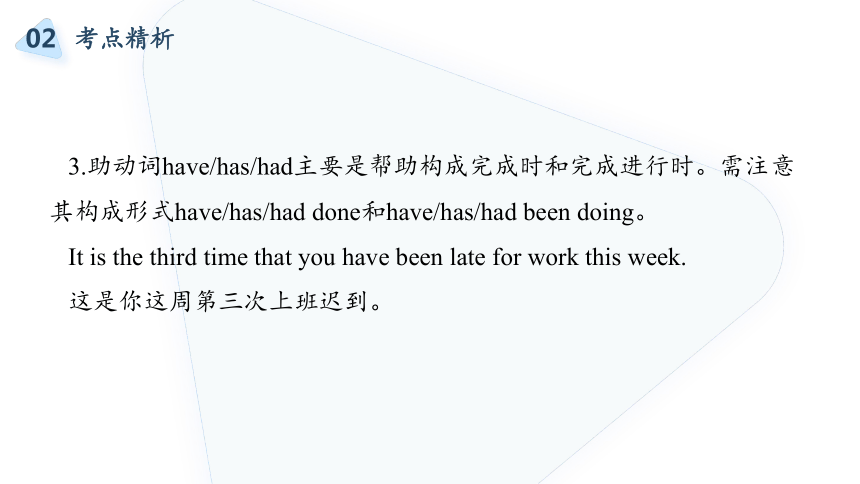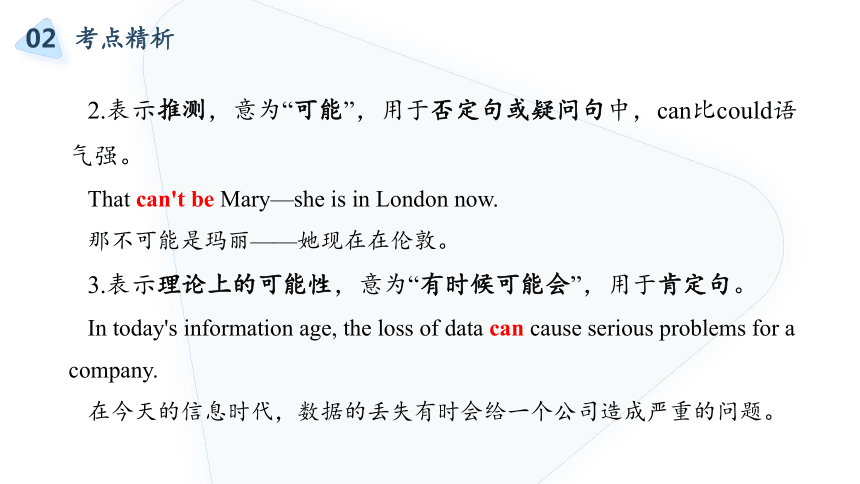2023届高考英语复习之语法透析:助动词和情态动词课件(32张PPT)
文档属性
| 名称 | 2023届高考英语复习之语法透析:助动词和情态动词课件(32张PPT) |  | |
| 格式 | pptx | ||
| 文件大小 | 182.6KB | ||
| 资源类型 | 教案 | ||
| 版本资源 | 通用版 | ||
| 科目 | 英语 | ||
| 更新时间 | 2022-06-26 06:58:17 | ||
图片预览












文档简介
(共32张PPT)
助动词和情态动词
2023届高考复习之语法透析
01
知识导图
情态动词
can , could, may, might, must, shall, will, should, would
不单独使用,情态动词+动词原形(be/do)
被动形式:情态动词+be done
表对过去的推测:情态动词+have done
过去完成时在虚拟语气中的应用
01
知识导图
助动词
帮助现在分词构成现在进行时(be+doing)
帮助过去分词构成被动语态(be+done)
与不定式构成be to do结构,表示将来、命令、约定等
be
do/does/did
have/has/had
will/would/shall/should
帮助动词原形构成疑问句或否定句
帮助动词原形构成强调句
用来代替动词
帮助过去分词构成完成时(have/has/had+done)或完成进行时(have/has/had been doing)
本身有一定的词义,表示说话者的情绪、态度或语气,和动词原形一起构成谓语
02
考点精析
考点一 助动词
1.助动词do/does/did主要帮助构成疑问句、否定句、部分倒装及强调句型。助动词do/does/did后只能跟动词原形,助动词不能用作实义动词。
He does deserve some good luck after so much wretchedness.
经过这么多苦难之后,他确实应该获得好运。
02
考点精析
2.助动词be/being/been主要帮助构成进行时、完成进行时和各种被动语态。需注意be虽然没有实际意义,却是这些结构中不可缺少的。
I am Li Hua,a student from Class 2,Grade 3.I am writing to apply for the position as a student volunteer.
我是李华,三年级二班的一名学生。我写信申请学生志愿者的职位。
02
考点精析
3.助动词have/has/had主要是帮助构成完成时和完成进行时。需注意其构成形式have/has/had done和have/has/had been doing。
It is the third time that you have been late for work this week.
这是你这周第三次上班迟到。
02
考点精析
考点二 情态动词的基本用法
情态动词
can/could,may/might, shall/should
常见的情态动词
基本用法
肯定形式:情态动词+动词原形
否定形式:情态动词+not+动词原形
will/would,need, dare, ought to
02
考点精析
can和could的用法
1.表示能力,意为“能、会”。
Samuel, the tallest boy in our class, can easily reach the books on the top shelf.
塞缪尔,我们班最高的男孩,能轻易地够到书架顶层的书。
It was several minutes before I could take in what he was saying.
过了好几分钟,我才理解他说的是什么。
02
考点精析
was/were able to表示过去有能力做并且成功做了某事,相当于managed to do sth./succeeded in doing sth.。
The fire spread through the hotel very quickly but everyone was able to get out.
尽管这场大火迅速蔓延到了整个宾馆,但是每个人都逃了出来。
02
考点精析
2.表示推测,意为“可能”,用于否定句或疑问句中,can比could语气强。
That can't be Mary—she is in London now.
那不可能是玛丽——她现在在伦敦。
3.表示理论上的可能性,意为“有时候可能会”,用于肯定句。
In today's information age, the loss of data can cause serious problems for a company.
在今天的信息时代,数据的丢失有时会给一个公司造成严重的问题。
02
考点精析
4.表示礼貌地请求,意为“能、可以”。在疑问句中could可代替can, 语气更委婉。
—Can you tell us your recipe for happiness and a long life
——你能告诉我们你幸福和长寿的秘诀吗?
—Living every day to the full, definitely.
——确信过好每一天。
02
考点精析
5.用于固定句式:can not...too/enough意为“无论……也不过分;越……越好……”。
I can't thank you too much for all your help to my son while we were away from home.
我非常感谢你,在我们不在家时帮助我的儿子。
02
考点精析
may和might的用法
1.表示许可和请求,在疑问句中might比may的语气更委婉。
Might/May I have a word with you It won't take long. 我可以和你说句话吗?不会耽误你很长时间。
2.表示推测,意为“可能、或许”,通常用于肯定句和否定句中。
If you forgot to turn it off when you went away, you might burn down the house.
如果你离开时忘记关掉它,你可能会烧毁整座房子。
02
考点精析
3.表示祝愿(不用might)。
May you succeed!
祝你成功!
4.用于固定句式:may as well+动词原形,意为 “最好、倒不如……”。
Since it is raining hard, you may as well stay here.
既然雨下得这么大,你倒不如待在这儿。
02
考点精析
must的用法
1.表示义务、必要性等,意为“必须”。其否定式mustn't 意为“禁止”。
—Can't you stay a little longer
——难道你不能再多待一会儿吗?
—It's getting late. I really must go now. My daughter is home alone.
——时间不早了。现在我必须得走了。我的女儿独自一人在家呢。
02
考点精析
2.表示猜测、推测,意为“想必、一定”。must常用于肯定句中。对现在或未来的事进行猜测时,用must do;对正在进行的事进行猜测时,用must be doing;对已经发生的事进行猜测时,用must have done。
You must be Carol.You haven't changed a bit after all these years.
你一定是卡罗尔。这么多年你一点都没变。
02
考点精析
3. 表示偏执、固执,意为“非得、偏要”。
If you must go, at least wait until the storm is over.
如果你非要走,至少要等到暴风雨停了。
02
考点精析
shall的用法
1.用于第一、第三人称疑问句中,表示说话人征求对方的意见或向对方请示。
Shall I tell Brett to come over straight after school tomorrow
我要告诉布雷特明天放学以后直接过来吗?
02
考点精析
shall的用法
2.用于第二、第三人称陈述句中,表示说话人给对方的命令、警告、允诺或威胁。
One of our rules is that every student shall wear school uniform while at school.
我们的规定之一就是每个学生在校期间都必须穿校服。
02
考点精析
should的用法
1.表示劝告和建议,意为“应该”。
I don't think you should give up the opportunity to go to university which you have been dreaming about.
我认为你不应该放弃你一直以来梦想的上大学的机会。
2.表示推测、可能性或预期,意为“应该、可能”。
He should be here on time—he started early enough.
他应该按时到这里的——他很早就出发了。
02
考点精析
3.用于表示感情或意志等的that从句中,意为“竟然……、居然……”。
It's strange that he should have taken the books without the owner's permission.
简直是太奇怪了,他竟然未得到主人的允许就把这些书拿走了。
02
考点精析
will和would的用法
1.表示意志或意愿,will指现在,would指过去。
I have told him again and again to stop smoking, but he will not listen.
我已再三告诉他戒烟,但他就是不听。
Days later, my brother called to say he was all right, but wouldn't say where he was.
几天后,我哥哥打电话说他一切都好,但不愿意说他在哪儿。
02
考点精析
2.表示习惯性的动作,意为“总是”,will指现在,would指过去。
I still remember my happy childhood when my mother would take me to Disneyland at weekends.
我仍旧记得我的快乐的童年,那时我妈妈经常在周末带我去迪士尼乐园。
02
考点精析
3.表示征求意见或提出请求,多用于第二人称疑问句中,would比will语气委婉。
Will/Would you please let me have a look at your new watch?
请让我看看你的新手表好吗?
02
考点精析
need的用法
1.need作情态动词时,表示必要性,常用于疑问句和否定句中,needn't表示“不必”。
My room is a mess, but I needn't clean it before I go out tonight. I can do it in the morning.
我的房间里乱糟糟的,不过我今天晚上出门之前没必要打扫,我可以上午再打扫。
02
考点精析
2.need 作实义动词时,可用于肯定句、否定句和疑问句中,有人称、数和时态的变化;其后可接名词、代词、带to的不定式或动词 ing形式作宾语。
Since you know it already, we don't need to keep it a secret.
既然你已经知道了,我们就没有必要保密了。
02
考点精析
dare的用法
1.dare意为“敢、敢于”,没有人称、数和时态的变化,主要用于疑问句、否定句和条件句中,后接动词原形。
How dare you leave your home without your parents' permission
在没有征得你父母同意的情况下你怎么敢离开家?
2.dare作实义动词时,在肯定句中通常接带to的不定式,在疑问句和否定句中,dare之后的不定式可省略。
Most people hate Harry but they don't dare to say so.
大多数人对哈利敢怒不敢言。
03
方法解读
方法一 意义和语气判断法
所谓意义判断法就是分析语境并确定应填情态动词的含义。因此熟练掌握每个情态动词的意义和用法是答题的前提。此外,情态动词主要表示说话人的语气、态度或情感,所以在解答此类试题时,要从说话者的角度去考虑问题,结合具体的语境来分析和判断,最后确定所需情态动词是否符合说话者的语气以及特定的情感需要。
George _____________________(not go) too far. His coffee is still warm.
表示对过去发生的事情非常有把握的否定推测
can't/couldn't have gone
03
方法解读
方法二 时间判断法
虚拟语气的考查重点在于判断句子是对现在、过去还是将来的动作进行虚拟。判断出时间后再根据相应的结构或句型确定谓语动词的形式。
I wish I ____________(be) at my sister's wedding last Tuesday, but I was on a business trip in New York then.
表示与过去事实相反的假设
had been
04
演练提升
1.People tend to focus on the first factor. However, greater attention should ____________(place) on longevity (长寿).
2.Jim says we ____________ stay in his house as long as we leave it clean and tidy.
be placed
can
04
演练提升
3.—Where is my Chinese book I remember I put it here yesterday.
—You ______________ have put it in the wrong place.
4.My suggestion is that a notebook _________________________ (keep) and a Chinese- English dictionary ______________ (be) within our reach.
must
(should) be kept(keep)
(should) be
Thank You!
助动词和情态动词
2023届高考复习之语法透析
01
知识导图
情态动词
can , could, may, might, must, shall, will, should, would
不单独使用,情态动词+动词原形(be/do)
被动形式:情态动词+be done
表对过去的推测:情态动词+have done
过去完成时在虚拟语气中的应用
01
知识导图
助动词
帮助现在分词构成现在进行时(be+doing)
帮助过去分词构成被动语态(be+done)
与不定式构成be to do结构,表示将来、命令、约定等
be
do/does/did
have/has/had
will/would/shall/should
帮助动词原形构成疑问句或否定句
帮助动词原形构成强调句
用来代替动词
帮助过去分词构成完成时(have/has/had+done)或完成进行时(have/has/had been doing)
本身有一定的词义,表示说话者的情绪、态度或语气,和动词原形一起构成谓语
02
考点精析
考点一 助动词
1.助动词do/does/did主要帮助构成疑问句、否定句、部分倒装及强调句型。助动词do/does/did后只能跟动词原形,助动词不能用作实义动词。
He does deserve some good luck after so much wretchedness.
经过这么多苦难之后,他确实应该获得好运。
02
考点精析
2.助动词be/being/been主要帮助构成进行时、完成进行时和各种被动语态。需注意be虽然没有实际意义,却是这些结构中不可缺少的。
I am Li Hua,a student from Class 2,Grade 3.I am writing to apply for the position as a student volunteer.
我是李华,三年级二班的一名学生。我写信申请学生志愿者的职位。
02
考点精析
3.助动词have/has/had主要是帮助构成完成时和完成进行时。需注意其构成形式have/has/had done和have/has/had been doing。
It is the third time that you have been late for work this week.
这是你这周第三次上班迟到。
02
考点精析
考点二 情态动词的基本用法
情态动词
can/could,may/might, shall/should
常见的情态动词
基本用法
肯定形式:情态动词+动词原形
否定形式:情态动词+not+动词原形
will/would,need, dare, ought to
02
考点精析
can和could的用法
1.表示能力,意为“能、会”。
Samuel, the tallest boy in our class, can easily reach the books on the top shelf.
塞缪尔,我们班最高的男孩,能轻易地够到书架顶层的书。
It was several minutes before I could take in what he was saying.
过了好几分钟,我才理解他说的是什么。
02
考点精析
was/were able to表示过去有能力做并且成功做了某事,相当于managed to do sth./succeeded in doing sth.。
The fire spread through the hotel very quickly but everyone was able to get out.
尽管这场大火迅速蔓延到了整个宾馆,但是每个人都逃了出来。
02
考点精析
2.表示推测,意为“可能”,用于否定句或疑问句中,can比could语气强。
That can't be Mary—she is in London now.
那不可能是玛丽——她现在在伦敦。
3.表示理论上的可能性,意为“有时候可能会”,用于肯定句。
In today's information age, the loss of data can cause serious problems for a company.
在今天的信息时代,数据的丢失有时会给一个公司造成严重的问题。
02
考点精析
4.表示礼貌地请求,意为“能、可以”。在疑问句中could可代替can, 语气更委婉。
—Can you tell us your recipe for happiness and a long life
——你能告诉我们你幸福和长寿的秘诀吗?
—Living every day to the full, definitely.
——确信过好每一天。
02
考点精析
5.用于固定句式:can not...too/enough意为“无论……也不过分;越……越好……”。
I can't thank you too much for all your help to my son while we were away from home.
我非常感谢你,在我们不在家时帮助我的儿子。
02
考点精析
may和might的用法
1.表示许可和请求,在疑问句中might比may的语气更委婉。
Might/May I have a word with you It won't take long. 我可以和你说句话吗?不会耽误你很长时间。
2.表示推测,意为“可能、或许”,通常用于肯定句和否定句中。
If you forgot to turn it off when you went away, you might burn down the house.
如果你离开时忘记关掉它,你可能会烧毁整座房子。
02
考点精析
3.表示祝愿(不用might)。
May you succeed!
祝你成功!
4.用于固定句式:may as well+动词原形,意为 “最好、倒不如……”。
Since it is raining hard, you may as well stay here.
既然雨下得这么大,你倒不如待在这儿。
02
考点精析
must的用法
1.表示义务、必要性等,意为“必须”。其否定式mustn't 意为“禁止”。
—Can't you stay a little longer
——难道你不能再多待一会儿吗?
—It's getting late. I really must go now. My daughter is home alone.
——时间不早了。现在我必须得走了。我的女儿独自一人在家呢。
02
考点精析
2.表示猜测、推测,意为“想必、一定”。must常用于肯定句中。对现在或未来的事进行猜测时,用must do;对正在进行的事进行猜测时,用must be doing;对已经发生的事进行猜测时,用must have done。
You must be Carol.You haven't changed a bit after all these years.
你一定是卡罗尔。这么多年你一点都没变。
02
考点精析
3. 表示偏执、固执,意为“非得、偏要”。
If you must go, at least wait until the storm is over.
如果你非要走,至少要等到暴风雨停了。
02
考点精析
shall的用法
1.用于第一、第三人称疑问句中,表示说话人征求对方的意见或向对方请示。
Shall I tell Brett to come over straight after school tomorrow
我要告诉布雷特明天放学以后直接过来吗?
02
考点精析
shall的用法
2.用于第二、第三人称陈述句中,表示说话人给对方的命令、警告、允诺或威胁。
One of our rules is that every student shall wear school uniform while at school.
我们的规定之一就是每个学生在校期间都必须穿校服。
02
考点精析
should的用法
1.表示劝告和建议,意为“应该”。
I don't think you should give up the opportunity to go to university which you have been dreaming about.
我认为你不应该放弃你一直以来梦想的上大学的机会。
2.表示推测、可能性或预期,意为“应该、可能”。
He should be here on time—he started early enough.
他应该按时到这里的——他很早就出发了。
02
考点精析
3.用于表示感情或意志等的that从句中,意为“竟然……、居然……”。
It's strange that he should have taken the books without the owner's permission.
简直是太奇怪了,他竟然未得到主人的允许就把这些书拿走了。
02
考点精析
will和would的用法
1.表示意志或意愿,will指现在,would指过去。
I have told him again and again to stop smoking, but he will not listen.
我已再三告诉他戒烟,但他就是不听。
Days later, my brother called to say he was all right, but wouldn't say where he was.
几天后,我哥哥打电话说他一切都好,但不愿意说他在哪儿。
02
考点精析
2.表示习惯性的动作,意为“总是”,will指现在,would指过去。
I still remember my happy childhood when my mother would take me to Disneyland at weekends.
我仍旧记得我的快乐的童年,那时我妈妈经常在周末带我去迪士尼乐园。
02
考点精析
3.表示征求意见或提出请求,多用于第二人称疑问句中,would比will语气委婉。
Will/Would you please let me have a look at your new watch?
请让我看看你的新手表好吗?
02
考点精析
need的用法
1.need作情态动词时,表示必要性,常用于疑问句和否定句中,needn't表示“不必”。
My room is a mess, but I needn't clean it before I go out tonight. I can do it in the morning.
我的房间里乱糟糟的,不过我今天晚上出门之前没必要打扫,我可以上午再打扫。
02
考点精析
2.need 作实义动词时,可用于肯定句、否定句和疑问句中,有人称、数和时态的变化;其后可接名词、代词、带to的不定式或动词 ing形式作宾语。
Since you know it already, we don't need to keep it a secret.
既然你已经知道了,我们就没有必要保密了。
02
考点精析
dare的用法
1.dare意为“敢、敢于”,没有人称、数和时态的变化,主要用于疑问句、否定句和条件句中,后接动词原形。
How dare you leave your home without your parents' permission
在没有征得你父母同意的情况下你怎么敢离开家?
2.dare作实义动词时,在肯定句中通常接带to的不定式,在疑问句和否定句中,dare之后的不定式可省略。
Most people hate Harry but they don't dare to say so.
大多数人对哈利敢怒不敢言。
03
方法解读
方法一 意义和语气判断法
所谓意义判断法就是分析语境并确定应填情态动词的含义。因此熟练掌握每个情态动词的意义和用法是答题的前提。此外,情态动词主要表示说话人的语气、态度或情感,所以在解答此类试题时,要从说话者的角度去考虑问题,结合具体的语境来分析和判断,最后确定所需情态动词是否符合说话者的语气以及特定的情感需要。
George _____________________(not go) too far. His coffee is still warm.
表示对过去发生的事情非常有把握的否定推测
can't/couldn't have gone
03
方法解读
方法二 时间判断法
虚拟语气的考查重点在于判断句子是对现在、过去还是将来的动作进行虚拟。判断出时间后再根据相应的结构或句型确定谓语动词的形式。
I wish I ____________(be) at my sister's wedding last Tuesday, but I was on a business trip in New York then.
表示与过去事实相反的假设
had been
04
演练提升
1.People tend to focus on the first factor. However, greater attention should ____________(place) on longevity (长寿).
2.Jim says we ____________ stay in his house as long as we leave it clean and tidy.
be placed
can
04
演练提升
3.—Where is my Chinese book I remember I put it here yesterday.
—You ______________ have put it in the wrong place.
4.My suggestion is that a notebook _________________________ (keep) and a Chinese- English dictionary ______________ (be) within our reach.
must
(should) be kept(keep)
(should) be
Thank You!
